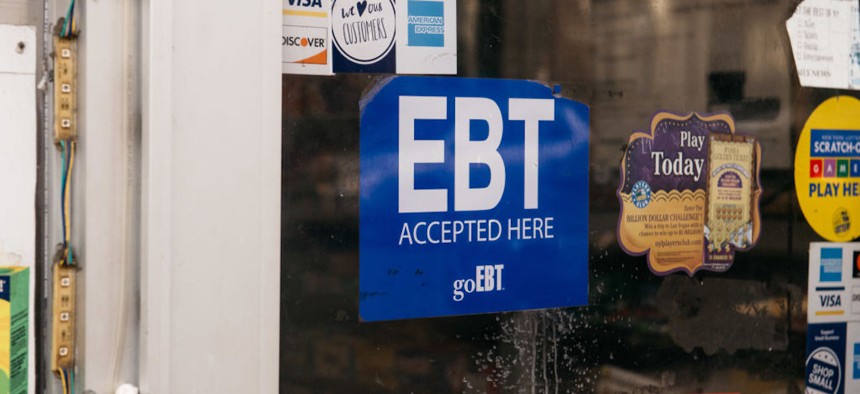AI could help clear food stamp backlogs plaguing some states

A sign alerting customers about SNAP food stamps benefits is displayed at a Brooklyn grocery store on Dec. 5, 2019, in New York City. Scott Heins/Getty Images
States are increasingly seeing it as a way to better process public benefit programs amid workforce shortages and outdated technology issues. But change can be incremental amid policy and money concerns.
In early February, 44 governors received letters from the U.S. Department of Agriculture warning them that their state is slipping in key benchmarks in the administration of food stamps.
Whether taking too long to approve applications, payment errors or inaccuracies in case determinations, the governors were directed to take immediate action to avoid further negative impacts on needy families.
And over the past year, nearly a million more people have begun receiving federal support through the Supplemental Nutrition Assistance Program, or SNAP. And many states have struggled to keep up with the increased demand amid workforce shortages and outdated technology.
Georgia, for instance, is facing a backlog of more than 46,000 SNAP applications. In response to a letter from federal regulators in November saying the state was “severely out of compliance” and ordering corrective action, Georgia officials proposed and got approval to use artificial intelligence to assist caseworkers with the certification process.
AI and automation hold tremendous promise in tackling many of the issues states like Georgia are experiencing in processing public benefit programs. Recognizing that, President Joe Biden’s AI executive order made special mention of the potential positives for benefits programs. And a January memo from the U.S. Department of Agriculture’s Food and Nutrition Service—which runs SNAP—noted that it has seen “increased interest” from state agencies in adopting automated technologies.
States have to get FNS approval for “major changes,” said Moira Johnson, the acting director of the agency’s Program Development Division. Already the service has approved the use of chatbots and virtual agents to deal with customer questions; robotic process automation to help prepare certification applications; and optical character recognition to scan verification documents and upload them.
Johnson says that “by themselves, bots are not much different from many state agencies’ eligibility systems that have more sophisticated functionality built into their system process.” States implementing these changes include Georgia, Kentucky, Massachusetts and Texas.
There is also increased interest in a “growing field” of advanced automated technologies, according to the agency, which can—among other functions—flag material or data for additional review or use machine learning.
To get approval, states would be required to show how they are mitigating potential bias and must explain how advanced automation technology is expected to affect program access, staff duties, system security, equitable program administration and privacy. States also will be required to summarize how they will audit actions taken by the technology to support appeals and monitor its accuracy and equity.
FNS said in the memo it “appreciates its partnership with state agencies and looks forward to engaging modernization efforts that help state agencies improve their administration of the program while maintaining a high level of customer service.”
The USDA memo comes on the heels of Biden’s executive order, which specifically cited benefits programs as one area where AI could be helpful. Experts have previously warned that while the technology can help unwind some of the “administrative muck” in benefits administration, it is not a silver bullet.
Major factors that stand in the way of state agencies implementing these innovations more widely include a lack of resources, the need for changes in policy and technology and enough lead time to ensure workers and recipients are properly trained.
Ki`i Kimhan Powell, senior director of policy at the nonprofit Benefits Data Trust, which advocates for streamlined access to government assistance, said that “this is incredibly hard work.”
She added that the financials are often the most challenging part of benefits modernization. Typically, the federal government will provide matching funds to cover some of the cost, but Powell says there are always “competing demands at a state for enhancing your technological system.”
It also takes time to implement technological updates, especially in concert with any policy updates that come down from the federal government or the state legislature. Powell said it can take between nine and 18 months to implement changes to a state’s benefits data system, as well as train people on new requirements.
States are also looking to more developed technology to help improve the process of applying for SNAP, too. Benefits Data Trust announced last month it would collaborate with agencies in seven states—Illinois, Iowa, Minnesota, Nevada, Oklahoma, Tennessee and Vermont—to help them establish or improve ways for SNAP applicants to sign their paperwork by telephone.
Telephonic signatures help simplify and speed up the application process by allowing applications to be signed by verbal attestation over the phone. It means agency staff do not need to mail paper applications and wait for them to be signed and returned, saving them time and helping applicants receive their benefits more quickly.
The USDA issued guidance in August 2022 on a waiver that allowed simpler collection of telephonic signatures. Previously, state agencies had been required to store an audio recording of an applicant’s verbal attestation. Telephonic signatures were first permitted in 2012. This partnership between Benefits Data Trust and the seven states will include technical assistance and monthly group meetings where they can receive peer support.
While not as technologically advanced as using AI to automate certain processes, it is all part of a broader mission to speed up benefits approvals and streamline applications. Powell said it and similar initiatives help create “more streamlined and dignified experiences for clients,” but it will take a lot of work to achieve a modernized, consistent experience.
“It is not just a technology solution, it is not just a policy solution, it is not just an operations solution,” she said. “It is going to take us working on all these different domains simultaneously and in conjunction with one another, to be able to move towards that more efficient and dignified experience. And it has to happen at all levels.”




